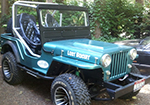 I was looking to see if anyone has generated a list of the top 15 things (or list of some kind) you should look at when evaluating the purchase of an older flattie for an upcoming post.
I was looking to see if anyone has generated a list of the top 15 things (or list of some kind) you should look at when evaluating the purchase of an older flattie for an upcoming post.
While looking for such a list, I ran across this article by a Willie Worthy (it turns out he wrote a number of tire histories), a writer for Four Wheeler Magazine. He takes a quick look back at how his life has changed and how it has remained the same. One of the more interesting descriptions he provides are the old school paddle tires.
Willie writes, “my first Jeep came with some military nondirectional 6.00-16s that were replaced with some 7.00-16s in a heavy-lugged mud and snow pattern. When I bought my new CJ-5 in the fall of 1962, it came with some 7.50-15s, which I quickly sold. By now, I was into tires and building rims. The tires of choice were some passenger-car 8.20-15 recaps spread out on my homemade 8-inch-wide rims. Later, I, and just about everyone I knew, was using Armstrong’s flotation tires, or similar versions of them that were originally designed for farm implements. Traction didn’t come from the straight grooves running the circumference of the tire but from their ability to conform to an obstacle. Soon we found that cross-grooving made for much better traction. The Pismo dunes, and those at Glamis, were wide open with no restrictions, and by the mid to late ’60s, we needed more traction than these tires would provide. Before the advent of paddle tires, we would cross-groove drag slicks in various patterns and mount them on 12- to 14-inch-wide homemade rims.”
